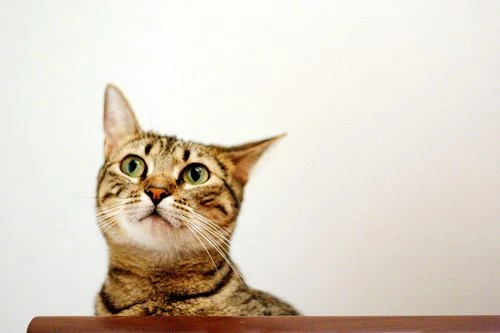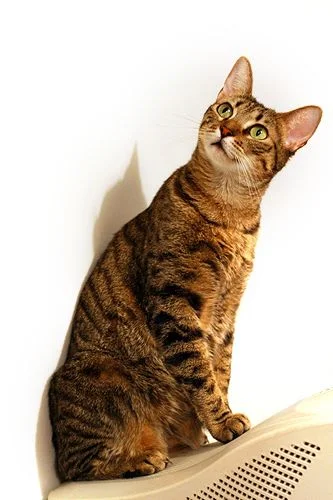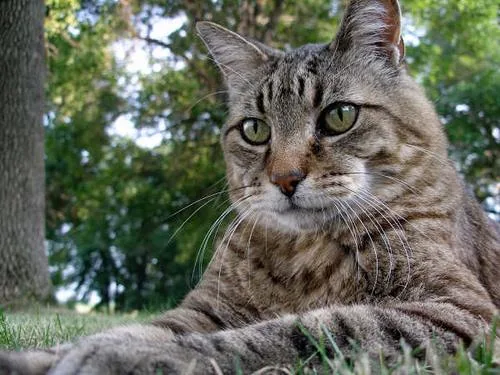
Cat Coats Tabby - Mackerel Tabby cat Chihiro - photo copyright fofurasfelinas reproduced under a creative commons license
Introduction - history
The tabby markings/color is probably the most common, in either domestic cats or wild cats (e.g. Scottish wildcat). When cats breed randomly over a long period of time, apparently the coat color and pattern tend towards brown mackerel tabbies with green eyes (the most common "phenotype" - meaning the observed expression of the genetic make-up).
RELATED: Why are tabby cats so common?
This indicates a genetic predisposition towards what is probably the most efficient coat color/pattern in respect of the cat's survival. There are three tabby patterns: the classic blotched pattern, the striped or mackerel pattern, and the spotted pattern. The Bengal cat for example can have a spotted tabby or blotched coat, while the Egyptian Mau has a naturally occurring spotted tabby coat - the only naturally occurring spotted domestic cat it is said.
The agouti ticked coat (the Abyssinian cat has the classic ticked coat) is a special kind of tabby coat.
As mentioned, you can see the tabby coat in wild cats such as the African wildcat and American Bobcat for example. However, I don't recall seeing a wild cat with what the cat fancy calls the "blotched" tabby coat. All wildcats appear to have spots and/or stripes or no tabby pattern. The blotched tabby appears to be a creation of the cat fancy or at least it has been "developed" and enhanced by the cat fancy (cat breeders).
 |
| Tabby cat from Ancient Egypt (not far from Saudi Arabia) from 1500 CE. Picture in public domain. |
Dr. Desmond Morris, the great zoologist and writer, tells us that it is believed that blotched tabbies arose first in Britain in the Elizabethan era. As you can see, they arrived very late during the evolution of the domestic cat. For the first 2,000 years or so or more all tabby cats were spotted/striped (broken stripes) tabbies and all domestic cats were spotted tabbies. And therefore, all domestic cat during the era of the ancient Egyptians were spotted/striped tabbies.
Dr. Morris says that the blotched tabby became a winner. In other words, a favourite and he is not sure why they did so well. Perhaps they were more healthy or more fertile than the other forms of tabby cat or perhaps they had an unusual level of aggressiveness or assertiveness. Perhaps people just like them and informally bread them?
RELATED: Evolution of the blotched tabby.
 |
| Development of the blotched tabby domestic cat. My thanks to the scientists of the study: The palaeogenetics of cat dispersal in the ancient world. |
Today, the blotched tabby is the most common form of tabby coat and the striped tabby has gone into somewhat of a decline. Of course, nowadays the tabby coat is just one of many types of coat that have evolved during domestic cat evolution. However, Dr. Morris reminds us that genetically and in reality all domestic cats are tabbies. If they don't appear to be tabbies it is because the tabby pattern is masked by the other non-tabby colours.
 |
| African wildcat compared with domestic cat. Image: MikeB from images in the public domain. |
Of course, the tabby pattern comes from the original domesticated wildcats. The North African wildcat has a week tabby pattern. And if we want to visualise the early domestic cats all you have to do is look at today's African wildcats. From paintings created in ancient Egypt we see that the Egyptian cats had light or broken stripes. When they were exported over thousands of years to other parts of the world including Europe, the cats began to hybridise with their European counterparts and the result was a full-tabby coat.
Tests have shown that when the week-tabby European and African wild cats were experimentally crossed the hybrid kittens developed coat patterns which were much closer to the full-tabby pattern of modern domestic cats according to Dr. Desmond Morris. I have quoted him verbatim.
 |
| Ginger blotched tabby. Photo: Pixabay. |
All tabby cats have the classic M marking on the forehead in varies styles and disguises.
An example of a purebred and pedigree tabby cat would be the American Shorthair. This breed looks particularly stunning in silver tabby. Another example of a beautiful purebred Maine Coon tabby can be seen by clicking on this link. The tabby pattern is often seen in Maine Coon cats. The cat associations allow a wide range of Maine Coon cat coat types (you'll see a great tabby MC on this link). There are some classic tabby patterns on wild cats. A good example is the tabby coat of the wildcats. These cats look very much like domestic cats as they are the wild ancestor of today's domestic cat.
Origin of Name
It is thought that the word, "tabby" originates in the appearance of silk sold in Baghdad (the Attabiyah region). This region must have been known for selling silks that had a striped appearance (watered - waved - silk) as incorporated into the name. Attabiyah is reference to the Latin attabi, and later the French tabis, which means, as I understand it, watered silk. As the striped and marbled tabby cats have the same general appearance, the word "tabby" was used to describe the coat.
 |
| Cat Coats Tabby - Mackerel Tabby cat Chihiro - photo copyright fofurasfelinas reproduced under a creative commons Attribution-NonCommercial-NoDerivs License |
The Genes
As mentioned, the wild cats have tabby coloration and patterns and the domestic cat is descended from the wild cat (see a comparison between the Scottish wildcat and domestic tabby). The pattern has 2 elements to it. (1) There will be a group of hairs in which the individual hairs have bands of color running horizontally up the hair strand. One band will be yellow and the next black. These hairs form the background color upon which the pattern is overlayed by the second group of hairs. The commonly spoken of "Agouti" gene (A) creates this banding pattern on the hair shafts. The banding on the hair shaft is due it is thought to a reduction in the production of the pigmentation granules or the production of a different and yellow pigment. This results in fewer granules that are spread more thinly throughout the hair follicle to give the beige/yellow looking color.
The pigment producing the black band in the hair shaft is called eumelanin and the yellow pigment is called phaeomelanin.
 |
| Tabby Hair Strand. Image: MikeB. |
If the band near the surface is beige you get the light brown broken effect and if the black banding is near the top the black is broken up by the beige banding lower down. (2) The other group of hairs will be black because the yellow banding referred to above will have been reduced (repressed) to the base of each hair or removed entirely. This group is seen as the spots or stripes or blotchy patches of black or brown that forms the patterns seen in the pictures. This effect is a result of the presence of the Tabby gene (Mc/mc), which is present in all cats and so are the markings but often sufficiently suppressed as to be invisible.
I know a small classic tabby that has also solid black hair in swathes, and also black hair with one band of beige near the surface which creates a speckled look on black. All these combinations are mixed together in various proportions and in varying sized clumps to produce the tabby pattern. The pattern that we readily see is due to the alternation of solid color (black fur) with the banded fur to create a pattern as mentioned above. It is the Primary Tabby gene (Mc) that dictates how the pattern will shape up for the individual cat.

Cat coats tabby - Tabby cat. This is a great photograph of a tabby cat. I just had to put it on this page. It is reproduced under a creative commons license.
There are several varieties of tabby markings and of course as mentioned an almost inexhaustible spectrum of colors, contrasts and pattern variations particularly in purebred cats where the appearance of the cat is of paramount importance.
Update 12th January 2011: See an article on red tabby cats and a nice picture of a Maltese red tabby.
Torbie
 |
| Gemma: Torbie Siberian Cat. Photo copyright Helmi Flick |
Read about torbies by clicking on the link below:
Tabby Cat Picture
There are a lot of tabby cat pictures on this page! People search for "tabby cat picture" so here is one of the best of a rescue cat by Giane Portal on Brazil. This is a classic blotched grey tabby cat - perfect example. You can see an orange tabby cat picture or two on this page.
| Dominique - photo copyright Giane Portal |
Mackerel Tabby

Cat Coats Tabby - Silver mackerel tabby cat - photo copyright Helmi Flick

Cat Coats Tabby - Cream and red mackerel tabby cats - photo copyright Helmi Flick

Cat Coats Tabby - Red mackerel tabby cat - photo copyright Helmi Flick

Cat Coats Tabby - Brown mackerel tabby cat - photo copyright Helmi Flick

Cat Coats Tabby - Blue and brown mackerel tabby cats - American curl cats - photo copyright Helmi Flick
The type we probably are most familiar with is the mackerel, stripped tabby. This is considered the wild type of tabby pattern. The genotype (the genes producing the black tabby coat) is A (agouti) + B (black) + D (dense coloration) + Mc (tabby gene).
Breeders like high contrast striping that is nice and evenly spaced and the stripe should be continuous. The Toyger has this. The Toyger also has a beautiful base or ground color that is incredibly warm (orange almost). The base color comes from the color of the agouti band on the individual hair strand. The warming up of the ground color is due to selective breeding in modifier genes (rufus modifiers). Click on the link to go to a pictures of cats.org videos of cats many of which are fundamentally tabby cats (YouTube, channel is broadsurf the YouTube name of Michael at Picture of Cats).
Classic Tabby

Blue classic tabby - photo copyright Helmi Flick

Red classic tabby - Maine Coon - photo copyright Helmi Flick

Cream classic tabby - photo copyright Helmi Flick

Brown classic tabby - photo copyright Helmi Flick

Silver classic tabby cat - This as you might have guessed is an American Shorthair cat. I have a post dedicated to the American Shorthair tabby cat. The silver is due to the Inhibitor gene I, which inhibits the production the yellow Agouti banding leaving the black to contrast more starkly with a gray/silver background.
The genotype (the genes producing the black tabby coat) of the classic blotched tabby cat is A (agouti) + B (black) + D (dense coloration) + mcmc (tabby gene). The difference to the mackerel tabby is the existence of the mc allele (allele = one of a pair of genes).
Spotted Tabby

Brown spotted Tabby - Bengal cat - - photo copyright Helmi Flick. Bengal cats are known for a very high contrast marbled pattern, see some superb examples by clicking on this link. Spots are another form of tabby pattern. You can see this beautifully expressed in the Bengal cat and/or, for example, the Ocicat.

Blue spotted tabby cat - - photo copyright Helmi Flick

Cream spotted tabby - Exotic Shorthair cat - photo copyright Helmi Flick

Silver spotted tabby - an example of the presence of the Inhibitor gene I - a Bengal cat - photo copyright Helmi Flick.
Research is still being carried out on the genetics behind the spotted tabby coat. It may be due to a modifier gene on the mackerel tabby. The striping of the mackerel tabby can break up and if that is captured and bred into the cat you'll get spots. In the Ocicat it seems that the effect is due to a dominant modifier of the blotched classic tabby pattern. Click on the link to see a video of the Ocicat on YouTube (this video is part of Pictures of Cats.org)
Ticked Tabby - Abyssinian Tabby

Cat Coats Tabby - Silver ticked tabby - Abyssinian cat - photo copyright Helmi Flick

Cat Coats Tabby - Red ticked tabby - photo copyright Helmi Flick

Cat Coats Tabby - Brown ticked tabby - photo copyright Helmi Flick.
Robinson's genetics says that the gene that produces the Abyssinian ticked coat is not the same gene as the tabby gene producing the classic and mackerel. They call it the "ticked gene". The authors say that the Abyssinian cat's appearance is a mutation of the normal tabby. The tabby pattern occurs on the head, legs and tail and very faintly elsewhere on the body. Breeders like to reduce the pattern further by careful breeding. The most frequently seen Aby color is the ruddy (red) - middle picture above - called the "usual". Breeders breed in a warmer color.
The full set of genes producing the well known Abyssinian coat are: AA (Agouti) - B (black) - D (dense coloration) - TaTa (ticked gene).
The tabby cat locus maps to the feline chromosome B1. It seems possible that the tabby gene has a homologue (common evolutionary origin) on human chromosome 8 or 4. (src: http://www.pubmedcentral.nih.gov/)
Interesting
This is an interesting bit of information about the tabby cat as camouflage, which comes from Desmond Morris's book "Catwatching". It had been proposed by a nineteenth century naturalist (I presume) that when a tabby cat is curled up she/he looks a bit like a "coiled snake". Once again this is a form of mimicry, one of a number of examples of the cats mimicry of the snake as an act defensive. Read about a cat hiss as another example.
A Torbie is a mixture of tabby and tortoiseshell. An example of tortoiseshell is the black tortoiseshell or just plain old tortoiseshell cats (this page has great pictures). Some people think the tabby cat is a cat breed.
See a Tabby Persian cat picture by Helmi Flick
Cat coats tabby - Photographs not captioned are copyright Helmi Flick and as follows:
- Top is a classic tabby
- 2nd is the mackerel tabby
- Messybeast
- Cat Fanciers
- Beth Hicks
- Robinson's Genetics




Can you please tell me if it is possible for two cats to have identical markings?
ReplyDeleteI believe it is, yes. It is certainly possible to have cat twins so that would imply that two cats can have the same coat.
ReplyDeleteHere are twin Persian cats
ReplyDeleteIs there a book with this information and beautiful pictures?
ReplyDeleteHi Judy, there is no book as far as I am aware.
Delete